How Japan’s Education System is Making a Difference in Egypt
2023.03.13
In February 2016, Japan and Egypt entered into the Egypt-Japan Education Partnership, or EJEP. The concept of the partnership was to work together in introducing various facets of Japan’s educational program into the Egyptian school system to strengthen the capacity of the nation’s youth. EJEP is very unique in that it covers various stages of education of Egypt, from education in early childhood, to basic, technical and higher education. Currently, two major projects are ongoing under this comprehensive partnership: the introduction of tokkatsu [a Japanese portmanteau of tokubetsu katsudo, or extracurricular activities] at Egypt-Japan School, or EJS; and the establishment and strengthening of the Egypt-Japan University of Science and Technology (E-JUST).
Today in Egypt, about 20,000 students in pre-primary and basic education, and 3,500 students in higher education are receiving their education based on the Japanese style. Imoto Sachiko, JICA Senior Vice President, had a chance to discuss these initiatives with Fayza Aboulnaga, the National Security Advisor to His Excellency President El-Sisi of Egypt, Chairperson of E-JUST Board of Trustees and Coordinator of EJEP.
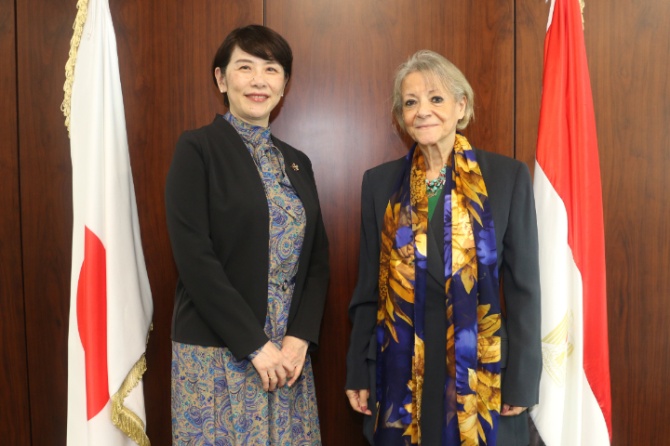
Fayza Aboulnaga (right) is the National Security Advisor to His Excellency President El-Sisi of Egypt, Chairperson of E-JUST Board of Trustees and Coordinator of EJEP. Imoto Sachiko (left) is Senior Vice President of JICA, with around 30 years of experience in international cooperation.
●Ms. Fayza Aboulnaga:
It began in 2002 during my visit to Japan as the Minister of State of Foreign Affairs. I observed people and children’s behavior in the street and everywhere else which attracted my attention. I saw little children of four or five years old going to school on their own, and people strictly respecting traffic lights to let children cross the street. In Egypt children of that age would always be accompanied by their parents. I came to the conclusion that there was a general standardization of behavior in Japan, common to everyone, and that the secret to this is the education system that produces quality human beings that make up the Japanese society. My next visit to Japan was with my husband, then the Egyptian ambassador to Japan. I told him that I wanted to visit the entire range of schools in Japan, from early childhood to higher education, including technical and vocational-training institutions to get to know the kind of education system that produces such standard behavior.
I spent a long time in classrooms, particularly those for children in their early childhood and primary school years, which is the most important stage. I observed how skilled teachers interacted with children, how they mixed boys and girls, how children were taught to respect others and to develop critical thinking. I saw children, teachers, and the headmasters cleaning their rooms, which was a very unique Japanese aspect. I saw the large open classroom windows so children could see the outside world with no barriers. I saw children learning to play sports, giving musical performances, washing their hands after a collective hot meal, and caring for their own hygiene.
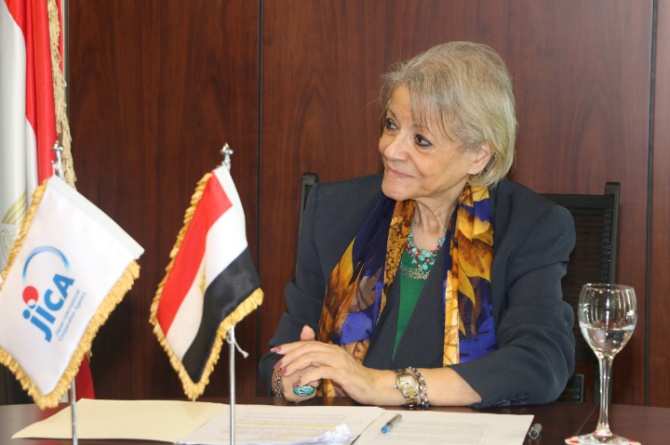
●Ms. Imoto Sachiko:
You have very rightly captured the core of Japanese education. It is very important for students to learn basic knowledge, of course, but the value of education is also to learn how to be responsible for and contribute to society. In order to build that responsibility, we not only need basic knowledge, but healthy bodies and healthy minds. Through school activities like the ones you mentioned, school becomes a miniature of society, in which children learn how they can contribute and care for each other. This is the concept of education in Japan.
●Ms. Aboulnaga:
President El-Sisi honored me by appointing me his Advisor for National Security in 2014. At one of our meetings prior to his 2016 visit to Japan, I told the President about what I had seen during my several visits to Japan. The President, who put education as a top priority, said he would like to visit a Japanese school during the President’s forthcoming visit to Tokyo. During his visit, he was supposed to spend one hour at a Japanese school. Instead, he actually spent almost three hours there and was very much interested in every step of that visit. My Japanese colleagues told me it was the first time for a visiting head of state to visit a Japanese school. It was during that visit that EJEP was agreed upon and announced by President Sisi and the late Prime Minister Shinzo Abe.
●Ms. Imoto:
You mentioned the cleaning activities, which the president must have seen. When we are at school, it’s our responsibility to clean the rooms where we spend time, so that we respect others who use them. We take turns serving lunch so that we learn to serve our peers in the community. In every aspect of these tokkatsu (extracurricular activities) children are encouraged to take care of themselves, listen to others, discuss the issues, and develop their own opinions as a member of the community.
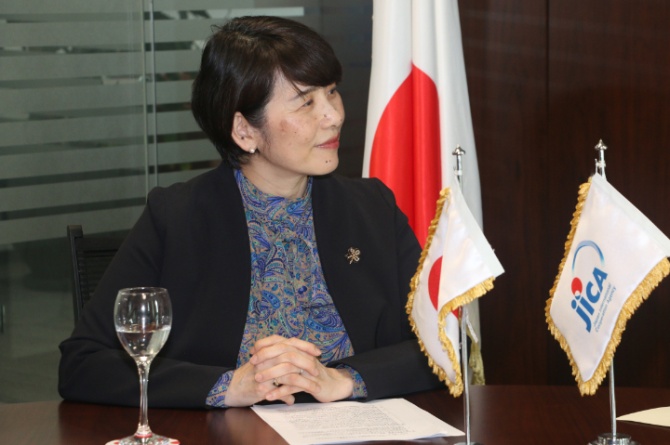
●Ms. Aboulnaga:
I was raised in a school in my native city of Port-Said with a similar system and similar principles, but the situation has drastically changed. The level of education has been adversely affected by the population increase, which led to overcrowded classrooms and the lack of proper training for teachers. After the signing of EJEP, we knew we had to better understand the concept of tokkatsu, so I visited Japan again with the then Minister of Education and a delegation of leaders from the Ministry of Education. A member of that delegation is now the Minister. We conducted an orientation session to understand tokkatsu and explain why Egypt was interested in the concept and the system. President Sisi agreed to launch 100 new Egypt-Japan Schools (EJS), with Japanese specifications and building standards based on the tokkatsu concept, in addition to rehabilitating 100 existing schools along the same lines, all of which would introduce and apply the tokkatsu activities with the help of Japanese experts. And here I must mention that President El-Sisi made the point to meet with those experts twice to make sure all necessary conditions are met for the success of this project. Today, both kinds of schools are successful. If you compare the students in schools implementing tokkatsu with non-tokkatsu schools, you’ll find a clear difference in behavior. Now the number of EJS and rehabilitated existing schools is growing all over the country, from big cities to small villages, covering the underprivileged class, lower-middle and middle classes.
●Ms. Imoto:
We are aware that introducing something new in education to foreign countries is always a challenge. So, we’re happy to see the tokkatsu concept and other facets of the Japanese education system succeed. When I visited an EJS on a trip to Egypt, I was amazed at the lively classroom discussions and the online parental attendance. It was fascinating to see how the Egyptian people had been able to adjust the system by exchanging ideas with Japanese experts in order to make it applicable to Egyptian content.
●Ms. Aboulnaga:
EJS parents in popular neighborhoods and small villages were happy to see that their children were cleaning their own schoolrooms, but those from the middle class were less accepting at first. Some of them complained, saying they were not sending their children to school to do cleaning. We explained the concepts at meetings with parents, and they not only understood but became very supportive of the new system. In fact, we heard stories of how their children’s behavior had changed: some children offered to help their mothers clean the house, and there were examples of children who would give up their seats on the bus to the elderly. This is the kind of change that comes from such a system of education. If we want to have a successful nation and a productive, progressive society, we need to educate people properly. Education is the key to sustainable development in any country.
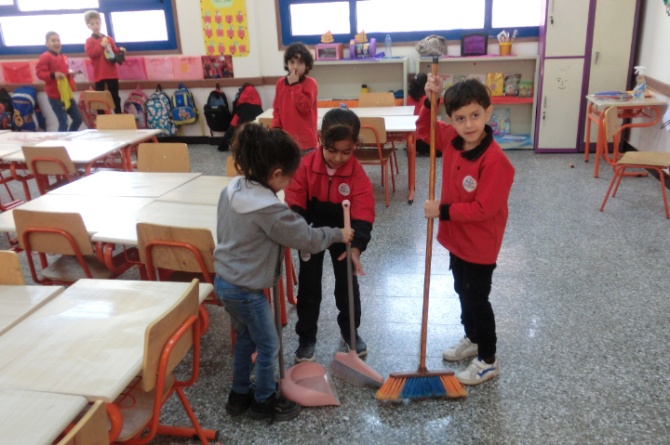
Children cleaning their own classroom at an Egypt-Japan School (EJS) is an example of the tokkatsu concepts being used in the Egyptian education system.
●Ms. Aboulnaga:
I proposed the idea of establishing E-JUST, the Egyptian/Japanese Center of Excellence of Science and Technology in Egypt as an institution that would also serve the Arab world as well as the continent of Africa. I asked Prime Minister Koizumi in 2002 during an official visit to Tokyo in my capacity as Minister of State for Foreign Affairs to give the relevant Japanese authorities the green light to study the proposal. After about a year and a half of preliminary study, both sides engaged in the necessary negotiations. It took about six years to finalize the agreement signed in 2009 to establish E-JUST. At the beginning, our Japanese friends were reluctant, since they had not done this in any country before, and understandably, did not want to take the risk of failure. It was the great Ms. Sadako Ogata, the president of JICA at that time [Ms. Ogata was also High Commissioner of UNHCR from 1991 to 2000], who changed the situation when she visited Egypt in 2006 and met with the Prime Minister. She immediately captured the interest of Japan in such project and realized the importance of establishing the Egypt Japan University of Science and Technology “E-JUST” as a new university with a strong orientation toward advanced scientific research and innovation which could be a foundation for industrial development in Egypt, the Arab world, and Africa: “E-JUST,” the first joint university of its kind for Japan. In fact, E-JUST and EJS and all the bilateral cooperation programs in the field of education provide an exemplary model for productive and mutually beneficial cooperation between any two countries. As a high Japanese official put it, “The education cooperation with Egypt made Japan realize it has an important export component to the outside world.”
●Ms. Imoto:
JICA’s cooperation on higher education usually supports capacity building of existing universities. However, at E-JUST we started from zero and had to build up everything all together from scratch. At the beginning, the Japanese side was skeptical to some extent, because it is difficult to make strong commitments that cover a long period of time. But Ms. Ogata was not afraid to take risks when it was the right thing to do.
●Ms. Aboulnaga:
I would like to express my personal everlasting gratitude to and sincere remembrance of my very dear friend the late Ms. Ogata for her strong support for the E-JUST project.. She strongly believed in making this happen and it was due to her conviction, her support, and her encouragement that a dream has come true. I remember her standing during the ground-breaking ceremony that took place in the middle of a piece of land in the desert, when it was hard to imagine that something viable would exist there someday. Now there’s an outstanding main campus, and a secondary campus, and state-of-the-art equipped laboratories and an ultra-modern library. Every time we have the Board of Trustees Meeting of E-JUST, I am so proud together with my dear friend Vice Chairperson Imoto-san, as well as the Egyptian and Japanese members of the Board to all of whom I am ever grateful, to register and follow continuous progress and see new horizons opening up. E-JUST has become a living model—indeed an icon of Egypt-Japan cooperation and an example resounding success, which proves that when there is a will there is a way; and I would add that when there is an Egyptian /Japanese will there are shining, promising, successful ways!
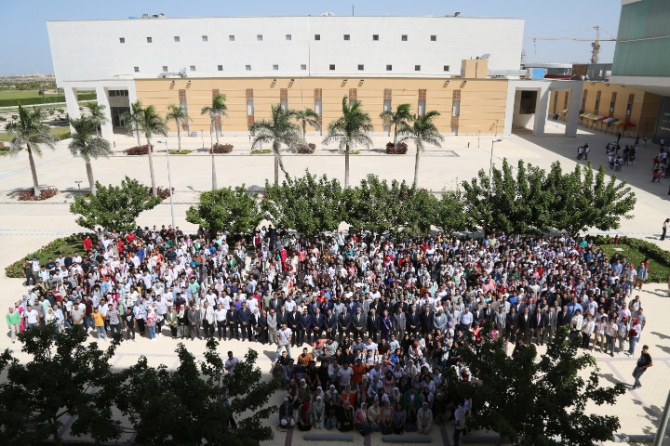
The main campus of Egypt-Japan University of Science and Technology (E-JUST) opened in 2019 and over 3000 students are studying as of Oct 2022.
●Ms. Imoto:
You mentioned “teamwork,” and it is very important that our Egyptian partners have both a strong will and strong leadership. We are very fortunate to have you, Ambassador Aboulnaga, Prof. Helal, the former Minister of Higher Education, and other members on this journey. We could not have achieved these results otherwise. Another factor of E-JUST's success is that it was clearly positioned as a model for reforming the large class, theory-centered education that is a characteristic of the traditional Egyptian engineering education. Japan’s higher education is characterized by small class sizes and practical, research-oriented education. Since its launch, the introduction of Japanese-style seminar-based classes has fostered an attitude of self-directed learning, including the proactive participation of the students. I hope to see more Japanese students studying at E-JUST and more Egyptian E-JUST students studying at Japanese universities in the future. They can learn from each other and form tight partnerships in school and on a personal level. Professors and schoolteachers from Japan could also learn a lot from Egypt.
●Ms. Aboulnaga:
Cooperation by definition is a two-way street, a process that brings our two countries much closer. In this regard, I insisted during the negotiation that humanities, liberal arts, and Japanese language study also needed to be introduced to E-JUST, in order to understand Japanese people, culture, and modality.
●Ms. Imoto:
With the EJS and E-JUST projects in Egypt, we are not copying the Japanese education system. We are trying to introduce it to fit the context of Egyptian society. Because Egypt is a leader in the Arab and African regions, if this educational reform is a success, it will be a good model for other countries to improve their own education systems. In the process, Japan can also learn a lot from the transformation of our partner countries as Japanese society is also changing.
●Ms. Aboulnaga:
Egypt now has a population of more than 105 million and growing. Of this number, 65 percent are under 35 years old, and 50 percent of those are under 25. This means Egypt is an old country with a young population; and as such Egypt must bear the responsibility for its people in terms of security, food, education, healthcare, housing, transportation, etc. Durable and sustainable development can only be ensured through developing well-educated generations of Egyptians. I repeat: Education is the key to sustainable development, progress and advancement of any nation. We believe Japan is a model to benefit from. Education is the key if our nation is to move forward. That’s why we are grateful for the cooperation with the Government of Japan, especially through JICA, our active and long-standing counterpart in this educational program. When it comes to education, the sky’s the limit.
●Ms. Imoto:
Thank you very much. I am so proud that JICA can be a partner in this cooperative project.
scroll